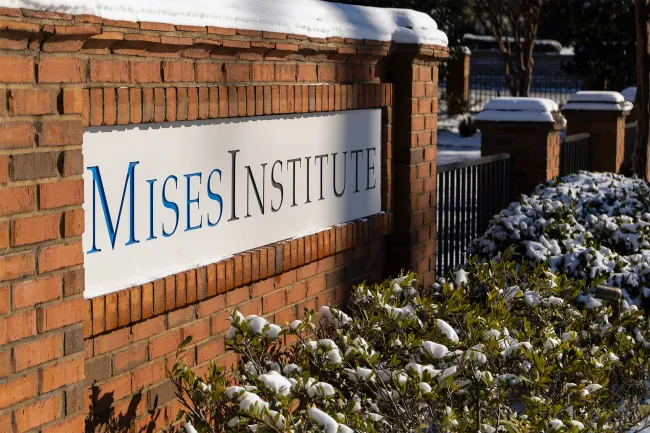Dear Secretary Bessent,
I read with great interest your July 21 comment at the Federal Reserve Capital Conference that: “What we need to do is examine the entire Federal Reserve institution and whether they have been successful. . . . All of these Ph.D.s over there, I don’t know what they do. . . . This is like Universal Basic Income for academic economists.”
Having been an academic Ph.D. economist for forty-one years I believe I can offer a little insight into whether the Fed has been successful (it unequivocally has not), as well as what “All of these Ph.D.’s over there” do. There is a mountain of academic research that shows that the Fed has failed on all counts. It has not only failed, but has made the economy far more unstable and with more price inflation than there was before the Fed existed, for one thing.
As for what all those Fed economists do, well, their Job Number One is to obfuscate these failures with their writings and speeches and to do their best to censor Fed Critics. Furthermore, since every Fed economist is a government bureaucrat, they all do what all government bureaucrats do: They are relentless lobbyists for bigger budgets, more power, a bigger staff, and more pay and perquisites for Fed employees. They also focus much of their research on the left-wing political fads of the day, such as “climate change,” racism, gender, inequality, and other projects of the political Left.
As for perquisites, I understand that you are a bit critical of the Fed’s spending $2.5 billion on renovations to its headquarters building in Washington, DC. Not for a new building, but for renovations of their already palatial headquarters. To put this into perspective, the cost of building Trump Tower (in the early 1980s), adjusted for inflation, was about $921 million. That’s building, not renovating. And people wonder why the Fed has never acquiesced in being audited. There is a large literature in the economics subdiscipline of public choice about how government bureaucracies tend to be budget maximizers, for that it show bureaucrats can personally benefit from the growth of government—bigger budgets means more prospects for higher pay, promotions, larger staffs, and myriad perquisites such as multi-billion-dollar buildings to work in. The Fed would appear to be the Mother of All Budget-Maximizing Government Bureaucracies. (Note that “budget maximizing” is a synonym for “cost maximizing,” the opposite of what every successful private business strives to do).
Secretary Bessent, I recommend that you read a study by Lawrence H. White, William Lastrapes, and George Selgin “commemorating” the centennial of the Fed entitled “Has the Fed Been a Failure?” These authors surveyed 195 peer-reviewed academic publications about the Fed’s performance from an historical perspective. On the Fed’s obligation to control inflation, they concluded that the Fed “has allowed the purchasing power of the U.S. dollar . . . to fall dramatically. A consumer basket [of goods] selling for $100 in 1790 cost only slightly more, at $108, than its equivalent in 1913 (the year of the Fed’s founding). But thereafter the price soared, reaching $2,422 in 2008.”
The highest annual rates of price inflation since the Civil War occurred “under the Fed’s watch,” these authors point out, referring to the high inflation rates of 1973-1975 and 1978-1980. They also concluded that prices became less predictable after the Fed was created, making economic calculation more difficult. Such uncertainty tends to stifle business investment because many businesses delay their plans if they are unsure of what their costs are going to be.
They cite the research of President Obama’s chief economist, Professor Christina Romer of the University of California at Berkeley, which shows that the business cycle was more volatile after the Fed was created than it was in the previous decades after the Civil War. The Fed is also responsible for the never-ending economic crises caused by its own policies, such as the ones we saw in 1953, 1957, 1960, 1969, 1973,1980, 1981, 1990, 2001, 2008, and 2020. Not to mention causing a depression in 1920 shortly after it was created, and fueling the stock market crash of 1929 less than a decade later. The Fed’s response to these crashes caused by its explosive monetary growth is always even more explosive monetary growth that fuels the next crash down the road.
The Fed employs around 500 of those academic economists you alluded to, and they compose a large army of Fed apologists and propagandists whose job is to invent fanciful theories in defense of the Fed, and to ignore research that is critical of the Fed. In 2005, Professor Lawrence H. White published a peer-reviewed journal article that highlighted the dominance of Fed-related (and often paid) economists in the field of monetary economics. In addition to its 500 or so academic economists on the Fed payroll, the Fed invites hundreds more to its conferences. Professor White found that 74 percent of all academic articles on monetary policy published by American economists in the year of his study were either in Fed-published journals or co-authored by Fed economists. As Milton Friedman once said, “If you want to advance in the field of monetary research. . . you would be disinclined to criticize the major employer in the field.”
Today’s Fed is just another Washington, DC, government-funded appendage of the Democrat party for the most part. In an Independent Review article entitled “Political Affiliations of Federal Reserve Economists,” Professor Emre Kuvvet found that the Democrat-to-Republican ratio at the Fed’s Board of Governors is 48.5:1. The Democrat-to-Republican ratio of Fed Board of Governor economists “in leadership positions” is 45:1. The Fed’s district banks are just as biased. The Federal Reserve Bank of San Francisco has twelve Democrats and one Republican economist. The Dallas Fed has sixteen Democrats and two Republican economists. The Philadelphia Fed has thirty-nine Democrat and five Republican economists. It is little wonder that Professor Kuvvet reports that research published by the regional Fed banks has become dominated by the topics of “race, gender, climate change, and inequality.” All of this is done by an institution that doggedly claims to be independent of politics!
When Fed economists are not busy publishing papers about climate change and “gender issues,” they are defending the massive central planning machinery of the Fed that regulates virtually all financial transactions of any kind, Soviet style. You mentioned in your July 21 speech that just one regulatory change in the Community Reinvestment Act recently included 60,000 words.
Perhaps the best example of this Soviet-style, central planning mindset that is inherent in the Fed is its insistence that one man—the Fed chairman—should have such influence as he has on interest rates. Interest rates should be set by supply and demand of loanable funds, incorporating the rates of time preference of individuals, and not by a Wizard-of-Oz-type character whose pronouncements keep the entire financial world sitting on the edges of its seats for every utterance of The Great Oz.
We have abolished central banks three times in our history—the Bank of North America, the First Bank of the United States, and the Second Bank of the United States. Today’s central bank is infinitely more insidious than the first three, for it is armed with armies of regulators, central planners, and propagandists and is arguably the largest governmental central planning bureaucracy on the planet, three-and-a-half decades after central planning was finally and conclusively discredited—or so we thought—with the worldwide collapse of socialism in the late 1980s/early 1990s. Finally, you were right to include that the Fed’s large stable of academic economists is a good example of “Universal Basic Income for academic economists.”
Sincerely,
Dr. Thomas DiLorenzo, President, The Mises Institute


